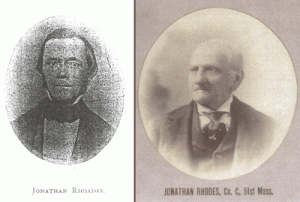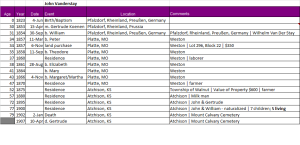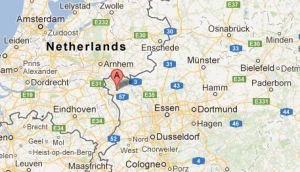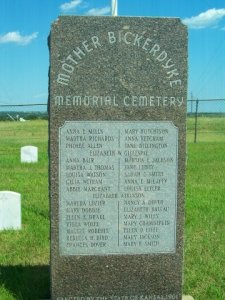How to Find Ancestral Records Using Friends, Associates, and Neighbors (FANs)
June 10, 2012 at 2:44 am | Posted in Genealogy Research Strategies, My Family History Stories | Leave a commentTags: genealogy research, genealogy research tips, using fans in genealogy
I suspect we all have “problem” ancestors. They are the ancestors that “play hard to get” and don’t give up their secrets so easily. John Vanderstay is one of my “problem” ancestors.
I have spent more than a decade attempting to nail down his immigration path. I knew he immigrated from Germany, or was it Holland? I was certain he first settled in Weston, Platte, Missouri, or did he settle somewhere on the east coast first? I was sure he arrived in 1857, but it could have been 1856 or 1858 maybe even 1855. Finally, I was absolutely confident that I had no idea through what port he entered or with whom he migrated. See what I mean? A “problem” ancestor.
The perplexing nature of this problem has been exacerbated by the sheer multitude of name spelling variations. I understand that spelling variations are one of the “givens” in the book of genealogy challenges. But in my experiences, the Vanderstays tilt the difficulty scale. Here is a sampling of the ways I’ve found it spelled. One, two and three word variations. Van vs. Von prefixes. Vanderstay or Vanderstag or staag or steng. Vanflustay. And the all time winner – Vandermaaij!
Tackling the Genealogy Problem with FANs.
From preeminent authorities down to us mere itinerant preachers of the Genealogy Gospel, have spoken of the wonders of researching not just an ancestor’s direct line, but looking at the world in which they lived in through the experiences of their “FANs” – friends, associates, and neighbors. Why, because our ancestors lived in communities, traveled in communities, and died in communities of people. And where you find their marriage witnesses, their children’s baptism godparents, their next door neighbors, their naturalization sponsors, their witnesses to deeds or probate, you find your ancestors. Look to your own life for evidence. In your life were any of the above witnesses, sponsors, neighbors your relatives?
Outline What the Known Facts
After many years of “hit and miss” research, I decided to get serious create a timeline of everything I knew about John Vanderstay and his immediate family. With a preponderance of research I had a fairly rich description of his life – albeit without the critical immigration story. I knew when and where he was born, married, had children, lived, sat out the Civil War, and died. Yet nothing pointed to his immigration other than knowing which children were born in Germany and which were born in Missouri, and letting that frame the probable period of migration.
Expand the Research to the Birth Family
John was one of five adult Vanderstay siblings who migrated and settled in Weston,Missouri. They were Catherine Vanderstay Gerlings, Frank Vanderstay, Anna Maria Vanderstay Foelling/Felling, and Wilhemina Vanderstay Merwick. I opted to start with Frank Vanderstay because he, unlike his sisters, didn’t change last names and complicate my research.
I outlined Frank Vanderstay’s life to clarify when he most probably migrated to America. Then I looked for his passenger record or naturalization record – anything that would tell me his migration story. Maybe he migrated with John?
And as luck – and a good strategy would have it – I came upon a passenger where which another researcher had identified as that of his great grandfather, Frank Vanderstay. The name, written on a torn and taped section of the record was transcribed “Frane Vandermaaij.” This seemed very promising. But we need to check these things out before “hurrahing!” and adding the record to the tree. Frank’s wife’s name was Elizabeth on the passenger record. That was right. Frank’s sisters, Wilhemina and Maria, were listed with their correct yet approximate ages. That’s good compelling evidence. Finally, there were two persons (a man and a woman ages 59 and 60) clearly listed as part of this family. Although the handwriting was hard to decipher, I can suspect that they were Frank’s parents. When the family members and ages correlated, I felt there was a case to be made that this indeed was the passenger record for Frank Vanderstay.
If this is correct, Frank came to America with his wife, parents, and two older sisters. Now I had a pool of FANs on which to base further research.
Which Nationality? German or Dutch.
Frank Vanderstay’s passenger record was in the database entitled Dutch Immigrants to America – New Orleans Passenger Records 1820 to 1845 on www.ancestry.com. Here Frank self-identifies as being from “Holland.” I did not expect to find the Vanderstays in a database of Dutch Immigrants. Further, I was surprised at Frank saying he’s from “Holland.” All of my research to date pointed to the family origin being Pfalzdorf, Germany. It seemed logical to look for them in German records. I’d never thought to look for them in Dutch passenger records.
Until this discovery and I looked at a map. Pfalzdorf is very, very close to Holland.
So Where’s John Vanderstay?
Now I had a record group or database in which to focus my research. Hurriedly, I typed in “John Vanderstay” in this singular database very eager to find John Vanderstay. And nothing. I tried every other spelling variation. Nothing. Surely, he must have migrated in the same or similar manner as his brother either before or after him but nothing was materializing in my searches.
Again, Remember the FANs.
I took a deep breath and looked to John’s extended birth family to search for another FAN in this database. I had accounted for three siblings (Frank, Anna Maria, and Wilhemina) coming to America, but not Catherine. Catherine married John Gerling in Germany! Maybe they migrated together with John and his wife, Gertrude? Gerling, I thought, was a more easily spelled last name than Vanderstay and I might have a better chance of finding it, so I tried it.
And viola! Catherine (Vanderstay) Gerling, her husband, John, and their three children (Johann, Wilhelm, and Heinrich). And a few lines up, there it was plain as day, Johann Von der Steny. Accompanying him were his wife, Gertrude, and son, Wilhelm. Finally, at the bottom of the same page the Foellings – Gerhardt, the soon-to-be brother-in-law of Anna Maria Vanderstay, his wife, children and parents. The three families arrived in the Port of New Orleans on April 28, 1856 on the ship, Fanny Fonsdick, as citizens of Prussia, mixed among other passengers from “Holland.”
Lessons Learned
John Vanderstay and dozen immediate and extended family members migrated to America and settled in Weston, Missouri. Then a year later almost to the date, the remaining members of this triad of families (Frank, Wilhemina, Anna Maria Vanderstay and their parents) followed their family members to America to complete the community.
If ever there was a testimony to the evidence of the power of FANs, I believe this to be it. I was up against a brick wall for a decade having only researched John Vanderstay and never finding his immigration story. However, it only took me a couple hours to break through the wall once I looked at his extended family.
Happy Researching.
Mysteries, Scandals, and an Ancestor’s True Identity Revealed
April 23, 2012 at 8:48 am | Posted in Genealogy Research Strategies, My Family History Stories | 2 CommentsTags: ancestor story, ancestor timeline, family story, jonathan rhoades, louise bolster, ma 51st infantry

- Jonathan Rhoades
images from http://www.nextech.de/ma51regt/
I honestly never gave a second thought to researching Jonathan Rhoades, even though I tell genealogists all the time to look beyond the blood line at friends, neighbors, and associates. You may recall Jonathan Rhoades was Louise’s second husband, who abandoned her, from a recent blog post – A Civil War Wife’s Story Told Through Genealogy Records. He was a mere supporting character in the drama of my ancestors, George and Louise Watson, so why bother looking into his story. Then a kind and loyal reader of this blog asked, did Louise ever get a divorce from Jonathan? Of course, I couldn’t let that lie. And I’m so grateful for the question, because in pursuing an answer a story rich in mystery, scandal, and family legends revealed came to life.
Who Was Jonathan Rhoades?
Jonathan Rhoades (b. 1817 Lynn, Essex, MA) was a shoemaker by trade his entire life. He must have been either very good or very proud of his profession because every document I touched called him out as a shoemaker. Which I must say, was a godsend in helping track him over time. Again, it is those extraneous facts we sometimes overlook that are the keys to genealogy success.
Jonathan at the ripe (old) age of 35 married Mary E. Allen (b. 1826, Albany, NY) in Southbridge, MA on January 27th 1852. They settled in to a conventional life by all indications, raising three children, Albert (b. 1848), William (b. 1853) and George (b 1854). You may notice Albert’s birth pre-dates the marriage. That could mean either this is the reality as is (birth before marriage), there was a transcription error somewhere, or another marriage. We just don’t know.
What we do know that is that tragedy befell the family in 1859. Mary died of “fever” at the young age of 33. Jonathan is now 42-years old, single with three dependent children. As is common for the time, single men did not raise children alone. Either they married seemingly quickly a suspiciously young bride or they found alternative arrangements for the children. The later is the case with Jonathan. William and George are raised in the home of Joseph U. Royce (age 69 in 1860) and Mary Williams Royce (age 64 in 1860) in Wales, Hampden, MA. Seemingly, as they are no longer able to care for them they are cared for by close neighbors and maybe relatives George and Mary Boynton.
By 1860 (US Census for MA), Jonathan is living as a single man, shoemaker by trade, in Mrs. Kendall’s Boarding House in Worcester, MA. In the boarding house were 15-20 adult men of varying ages all tradesmen by profession – tinmen, painters, polishers, carriage painters, blacksmiths and wire drawers. It’s not hard to imagine a rough and tumble, very manly lifestyle Jonathan experienced at this stage of his life. Sad, too, he’s lost his wife … and children.
Jonathan Rhoades and the War
The country had been at war from April of 1861 and by the time Jonathan had enlisted in the late summer/early fall of 1862, Lincoln was calling for another 300,000 troops and the cities and towns were offering a bonus for enlisting to get recruits. As a Private, his occupation at the time of his enlistment, was a bootmaker. For more on this regiment visit the 51st Massachusetts Volunteer Infantry Site. Know that at this time in our American history we were an all-volunteer army and Jonathan enlisted as a volunteer as most men did at the time. Indeed, the draft did not come into play until 1863, at which time Jonathan officially registered for the draft – occupation: shoemaker.
Jonathan and Louise
While Jonathan is married and having children in the early 1850s, Louise had married Francis Bullard, and they had two children – Elvira Josephine and Walter Henry. Additionally, by 1862, Francis, like Jonathan, had enlisted in the Massachusetts militia. However, unlike Jonathan, his fortunes were short-lived, dying in battle in September 1862.
With the fall of 1862 upon them Louise and Jonathan were both widow and widower having had children and each a family. I can see where when their paths crossed they found common cause. By November 1862 – only two months after Francis died – they wed.
New records recently discovered force changes to my original narrative of their lives. According to the 1865 Massachusetts Census for Worcester, MA, Jonathan and Louise are still the tight little family in 1865! (I had thought they were separated by 1865.) Jonathan’s children are not in the household, but Louise’s children from her marriage with Francis (Elvira and Walter) are with the family. Realize, too, that Louise had set up a guardianship for Elvira and Walter with Allen Price two years earlier. Nonetheless, she retained custody – at least until May 1st, 1865, when the census was taken.
Just to recap –
- Jonathan and Louise are still together in 1865
- Jonathan gives away his children from his first marriage – at least they are not with him.
- Louise legally gives up custody of her children from her first marriage.
- Jonathan and Louise keep Louise’s children from her marriage with Francis Bullard.
Then we have Francis. Little Francis Rhoades joins the family in September of 1864 to be recorded as eight months old in the 1865 MA Census. The family was growing. Life was looking up and settled.
Louise and George
But wait! You might exclaim, if you recall I previously had George and Louise wed in 1863. How could they possibly be married if Jonathan and Louise are married in 1865? Very easily. I made a mistake.
George, upon further investigation, did return from battle and stayed at home with his parents, Samuel and Olive Watson at least through 1865 to be identified in that same census. Further, it seems George and Louise were married in 1867, not 1863. There it was clear as day on the marriage register. Ooops.
I also noticed in revisiting the marriage register was who exactly George married. George married a “Maria J. Bullard” from Clayton, Michigan. Both listed the event as their first marriage. But look at the name of the bride – Maria (Louise’s middle name) and Bullard (from her first marriage). Additionally, I know she’s given her name in pension records as “Louise M J Bullard.” I’m certain she is Louise. I’m also certain this is the right George H. Watson, because the parent names (Samuel B. and Olive) are exactly correct in the register, and they aren’t the common Mary and John-type names to be easily confused.
It’s clear to me that Louise married to George under an assumed name. She never divorced Jonathan, as we might infer from her statement “he (Jonathan) abandoned me” in the pension records. She seemingly didn’t want it exposed that she was marrying illegally. Why she picked place of residence as Clayton, Michigan, I don’t know. Maybe she felt it couldn’t be disputed or she identified easily with a distant location. Louise, you sneaky girl.In November of 1867, Louise and George form a family, and by 1870 they are inDes Moines, Iowa on their way to Kansas to start a new life.
What About the Children?
What became of Elvira Josephine and Walter Henry and Francis Rhoades? Before I answer that, I do want to confirm that Jonathan did go his own way. By 1870 he was living with a family, who must have offered a small boarding house connected to the home. There were a handful of adult men – railroaders mostly – living there with Jonathan, the shoemaker. He remained inWorcester Countythe rest of his life dying at the age of 82 and was buried in the Lynn Cemetery with a GAR (Grand Army of the Republic) headstone.
As for Elvira and Walter, they were, as mentioned in the first blog post, given to Allen Price. But we now know it was sometime between May of 1865 and November of 1867.
And Francis?
It is my belief, for reasons I’ll explain, that Francis Rhoades stayed with George and Louise and became the man we know as Frank Watson.
- There has always been a family legend that Frank Watson was adopted. This would support that case.
- In spite of exemplary vital records kept in Massachusetts, I’ve never found a birth record for Frank Watson. If what I’m saying is true, “Frank Watson” was never “born.”
- Frank Watson in every record throughout his life maintains he was born in 1864. George and Louise didn’t get married until 1867. Indeed, Louise was married to Jonathan until 1865. They couldn’t have been Frank’s biological parents.
- Francis Rhoades was born in September 1864 – exactly the time presumed to be Frank Watson’s birth.
Therefore, it is my contention that Frank Watson’s biological father is Jonathan Rhoades.
In Conclusion…
What a heart-stopping journey this has been. Abandonment. Illicit marriage. Assumed names. Changes of identity. A mystery writer couldn’t have concocted this with any measure of believability. But it is true, or so the records would have us believe. Speaking of records, I don’t source my stories in detail in the blog. However, if you would like the detailed timeline with sources – all 26 of them – I’d be happy to share.
And in the meantime, happy researching.
Vincent & Maria Smarsh
April 19, 2012 at 12:32 am | Posted in My Family History Stories | Leave a commentTags: Vincent & Maria Seizburg Smarsh
If you’ve read the last post about “Uncovering the Reasons for an Ancestor’s Migrations,” then you are well acquainted with Vincent and Maria Seizburg Smarsh. I thought it only appropriate that you see them “in person.” This picture is from Harvesters of the Prairie – the 100 Year Centennial commorative book of St. Marks, KS.
Uncovering the Reasons for a Ancestor’s Migrations
April 17, 2012 at 1:47 am | Posted in Genealogy Research Strategies, My Family History Stories | 1 CommentTags: creating an ancestor's narrative, family history story, using census data to answer questions, using local histories to fill out a story
I’ve diligently worked to understand the life of my maternal gggrandfather, Vincent Smarsh (b. 1804 Austria, d 1882 Kansas) – copiously gathering records for years. From my records the story of an immigrant’s migration was clear. Leaving Austria he and his young family arrived in Pennsylvania then migrated to Kansas through Tennessee in the years between 1854 and 1872 all within the backdrop of the historic transformation of America during the Civil War. Continue Reading Uncovering the Reasons for a Ancestor’s Migrations…
A Civil War Wife’s Story Told Through Genealogy Records
April 4, 2012 at 1:32 am | Posted in My Family History Stories | 7 CommentsTags: 15th Massachusetts Volunteers, civil war widow, civil war women, francis bullard genealogy, george h watson genealogy, louise bolster genealogy, mother bickerdyke memorial cemetery, telling an ancestor's story through genealogy
Louise Bolster (b. 1836, MA, d. after 1910 KS) is my gggrandmother and wife of the only Civil War Veteran in my family tree. In gathering the records for her husband, George Watson, her life started to unfold. And quite unexpectedly it became more interesting, had more twists and turns, had more intrigue than arguably her husband’s story – and he fought at Gettysburg! To me, it demonstrated a unique spirit and resilience in the face of war that heretofore, I had not thought twice about being present among the spouses of soldiers.Here’s Louise’s story. You can judge for yourself what kind of woman she was.
Louise as Young Bride and Mother
Louise was born in 1836 in Barre, Worcester, Massachusetts . This hamlet of a town with a population of fewer than 3,000 in 1860 is located in rural central Massachusetts.
At the tender age of 16, Louise married Francis Bullard, a carpenter, in 1852. She married him on the Fourth of July. It’s hard to imagine that the date was chosen serendipitously.
The couple settled down and began to raise a small family. Elvira Josephine, born August 9, 1855 and Walter Henry, born June 14, 1858, join the family. This family would go about their lives in complete anonymity, were it not for the War which changes everything. Continue Reading A Civil War Wife’s Story Told Through Genealogy Records…
-
Join 69 other subscribers
Post Categories
Archives
Create a free website or blog at WordPress.com.
Entries and comments feeds.





